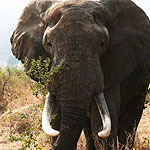Kavango-Zambezi Transfrontier Conservation Area treaty signed3rd October 2011  The Southern African Development Community (SADC) Summit in Luanda, Angola, the Presidents of the Republics of Angola, Botswana, Namibia, Zambia and Zimbabwe have recently signed (18th August 2011) signed a binding Implementation Treaty which has established the Kavango-Zambezi Transfrontier Conservation Area (KAZA TFCA) - home to Africa’s charismatic Big Five: leopard, rhino, buffalo and lion, and continent’s largest contiguous elephant population in northern Botswana and western Zimbabwe. Other rare, vulnerable and endangered wildlife species to benefit from this new treaty include cheetah, black rhino, African wild dog, sable and roan antelope, puku, oribi, honey badger, wattled crane and Cape vulture. The Southern African Development Community (SADC) Summit in Luanda, Angola, the Presidents of the Republics of Angola, Botswana, Namibia, Zambia and Zimbabwe have recently signed (18th August 2011) signed a binding Implementation Treaty which has established the Kavango-Zambezi Transfrontier Conservation Area (KAZA TFCA) - home to Africa’s charismatic Big Five: leopard, rhino, buffalo and lion, and continent’s largest contiguous elephant population in northern Botswana and western Zimbabwe. Other rare, vulnerable and endangered wildlife species to benefit from this new treaty include cheetah, black rhino, African wild dog, sable and roan antelope, puku, oribi, honey badger, wattled crane and Cape vulture.
Spanning over 444,000 km² and incorporating a number of national parks, game reserves, forest reserves, conservancies and wildlife management areas embedded within a matrix of land under traditional communal tenure,the KAZA TFCA will potentially become the world’s largest conservation area. It is situated in the Okavango and
Zambezi river basins where the borders of Angola, Botswana, Namibia, Zambia and Zimbabwe meet. The KAZA TFCA process, primarily supported by the German Federal Ministry for Cooperation and Development through
KfW, evolved from two initiatives - the Okavango Upper Zambezi International Tourism Initiative and the “Four Corners” Transboundary Natural Resource Management initiative.
By signing this Treaty, the five states aim to ensure implementation of the goal of the KAZA TFCA, which is “to sustainably manage the Kavango Zambezi ecosystem, its heritage and cultural resources based on best conservation and tourism models for the socio-economic wellbeing of the communities and other stakeholders in and around
the eco-region through harmonization of policies, strategies and practices.”
More information is available through the Kavango-Zambezi Transfrontier Conservation Area website, or through the Global Transboundary Conservation Network.
|